Moscow-Riga Railroad Bridge is a concrete arch bridge that spans the Moscow Canal between Tushino and Shchukino Districts in northwestern Moscow, Russia. The bridge does not have an official name and is sometimes called the Railroad bridge over Moscow Canal. It was completed in 1936, designed by A.S.Bachelis. [1] [2]
Construction of Moscow Canal (1932-1938) required building a new railroad bridge on a track running over the lower chamber of Lock No.8., near the village of Shchukino, which at this time was far outside the city limits. Tram service to Shchukino was started soon afterwards in 1938, [3] but urban development didn't began until the 1960s.
The bridge is 200.8 metres (659 ft) long and 20.0 metres (65.6 ft) high. The main span is 120 m (390 ft) long and 17.5 m (57 ft) high, consisting of a simple Mayard box profile with a 4.1 m (13 ft) span between side walls, equidistant between track centres. The upper and lower walls of the box are 9.5 and 8.06 m (31 ft 2 in and 26 ft 5 in) wide. Inside, the arch box has diaphragm braces (30 cm (12 in) thick on 4.1 m (13 ft) spacing, with corresponding vertical beams on the outer walls. Each arch stands on concrete foundations 34.3 by 19.2 m (113 by 63 ft), supported by 992 wooden piles. The upper deck rests on concrete girders (one for each track), 3.5 m (11 ft) high; their width varies from 50 to 70 cm (20 to 28 in).
This bold bridge has become an icon of pre-World War II soviet propaganda, including on a postage stamp (January 1941) and in movie appearances. According to the most recent studies (1990 [4] ), the bridge is structurally safe and sound, although its unpainted concrete may look rusty upon close inspection.

Bolshoy Kamenny Bridge is a steel arch bridge spanning Moskva River at the western end of the Moscow Kremlin. Its predecessor was the first permanent stone bridge in Moscow, Russia. The existing bridge was completed in 1938 by engineer Nikolai Kalmykov.

Andreyevsky Bridge name refers to a historical bridge demolished in 1998 and three existing bridges across Moskva River, located between Luzhniki and Gorky Park in Moscow.
The name Krasnoluzhsky Bridge refers to three existing bridges across Moskva River, located between Kievsky Rail Terminal and Luzhniki in Moscow.

Smolensky Metro Bridge is a steel arch bridge that spans Moskva River in Dorogomilovo District of Moscow, Russia. It is the first bridge built for the Moscow Metro in 1935–1937, designed by N.P.Polikarpov, P.K.Antonov and Yakovlev brothers. It is one of two bridges over Moskva River that are used exclusively by Metro (subway) trains, while the other Metro bridges combine road and rail.

Zverev Bridge is a pedestrian arch bridge that spans Vodootvodny Canal in Zamoskvorechye district of downtown Moscow, Russia. It was built in 1930 by N.Ya.Kalmykov and I.A.Frantsuz.
Bolshoy Ustinsky Bridge is a steel arch bridge that spans Moskva River near the mouth of Yauza River, connecting the Boulevard Ring with Zamoskvorechye district in Moscow, Russia. It was completed in May 1938 by V.M.Vakhurkin, G.P.Golts and D.M.Sobolev.
Novospassky Bridge is a steel plate girder bridge that spans Moskva River, connecting Novospassky Monastery and Paveletsky rail terminal areas in Moscow, Russia. It was built in 1911, as a triple-span steel arch bridge. Reconstruction in 2000 replaced arches with a simpler plate girder structure. Note that the memorial plaque on the bridge spells its name Ново-Спасский, with dash, despite tradition and spelling rules.
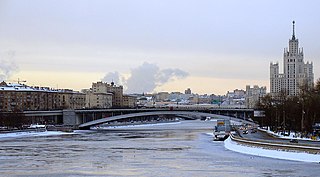
Bolshoy Krasnokholmsky Bridge is a steel arch bridge that spans Moskva River in downtown Moscow, Russia, carrying Garden Ring between Tagansky District and Zamoskvorechye Districts. It was completed in 1938 by V.M.Vakhurkin, G.P.Golts and D.M.Sobolev. Its main span is the widest arch span in Moscow.
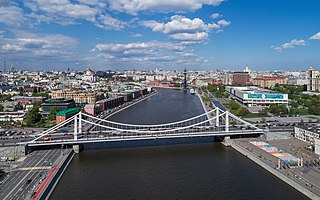
Krymsky Bridge is a steel suspension bridge in Moscow. The bridge spans the Moskva River 1,800 metres south-west from the Kremlin and carries the Garden Ring across the river. The bridge links the Zubovsky Boulevard to the north-west with Krymsky Val street to the south-east. The nearby Moscow Metro stations are Park Kultury and Oktyabrskaya.

Bolshoy Moskvoretsky Bridge is a concrete arch bridge that spans the Moskva River in Moscow, Russia, immediately east of the Kremlin. The bridge connects Red Square with Bolshaya Ordynka Street in Zamoskvorechye. Built in 1936–1937, it was designed by V. S. Kirillov and Alexey Shchusev.

Borodinsky Bridge is a steel plate girder bridge that spans Moskva River, connecting Dorogomilovo District and Kievsky Rail Terminal with the centre of Moscow, Russia. The bridge was built in 1911–1912 as deck arch bridge by N.I. Oskolkov, M.I. Schekotov and Roman Klein. In 2001, the bridge was reconstructed, replacing arches and deck with a plate girder structure.

Sadovnichesky Bridge is a cоncrete pedestrian arch bridge that spans Vodootvodny Canal in historical Zamoskvorechye district of Moscow, Russia. The bridge connects Balchug island with Zamoskvorechye mainland. It was built in 1963, designed by Nina Bragina, V.A. Korchagin and K.P. Savelyev. It is Moscow's nearest adaptation of a Moon bridge.
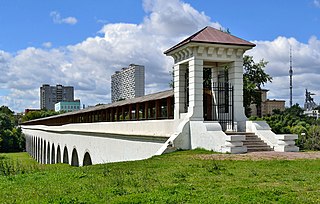
Rostokino Aqueduct, also known as Millionny Bridge, is a stone aqueduct over Yauza River in Rostokino District of Moscow, Russia, built in 1780-1804. It is the only remaining aqueduct in Moscow, once a part of Mytishchi Water Supply, Moscow's first centralized water utility.
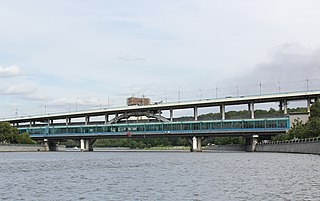
Luzhniki Metro Bridge, also known as Metromost (Метромост), is a concrete double-decked (two-level) arch bridge carrying a road and a Moscow Metro line across the Moskva River in Moscow, Russia. It connects the neighbourhood of Luzhniki Stadium to Sparrow Hills. The bridge houses Vorobyovy Gory, the only station of Moscow Metro located over water. Designed in 1958 by V.G. Andreyev and N.N. Rudomasin, the bridge rapidly decayed and was rebuilt in 1997–2002.

Shlyuzovoy Bridge is a concrete cantilever bridge in Moscow, Russia, spanning the eastern extremity of Vodootvodny Canal and connecting right-bank embankments of Moskva River. Existing bridge was completed in 1965 by engineer Z.V. Freydina.

The Church Street Bridge is an historic road arch bridge over the Yarra River and the Monash Freeway in Melbourne, Victoria, Australia. It links Church Street in Richmond on the north bank with Chapel Street in South Yarra on the south.

The Godavari Arch Bridge is a bowstring-girder bridge that spans the Godavari River in Rajahmundry, India. It is the latest of the three bridges that span the Godavari river at Rajahmundry. The Havelock Bridge being the earliest, was built in 1897, and having served its full utility, was decommissioned in 1997. The second bridge known as the Godavari Bridge is a truss bridge and is India's third longest road-cum-rail bridge crossing a water body.

Maly Krasnokholmsky Bridge is a bridge over the Vodootvodny Canal in Zamoskvorechye District in Moscow, Russia. This is one of the three bridges included into the Garden Ring, a ring road encircling the city center. The bridge connects Nizhnyaya Krasnokholmskaya Street and Zatsepsky Val Street. The length of the bridge is 70 metres (230 ft).
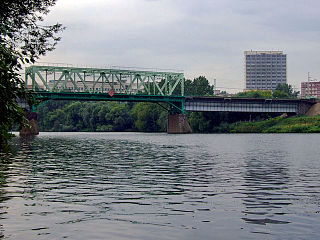
The Belarusian railway bridge in Moscow is a three-span steel girder bridge over the Moscow River, located on the Belarusian suburban direction of Moscow Railway. It is the outcome of a structure built in 1895, which was renovated twice – in 1938 and 1961.